Key takeaways:
- Creating a sense of community and shared experiences among participants enhances engagement and motivation in art settings.
- Setting clear, attainable goals and celebrating small victories fosters confidence and reinvigorates motivation during artistic projects.
- A welcoming atmosphere, characterized by genuine interactions and showcasing diverse perspectives, promotes inclusivity and deeper connections among attendees.
- Utilizing interactive elements and encouraging personal reflections in exhibitions can elevate the viewer’s experience and inspire creativity.
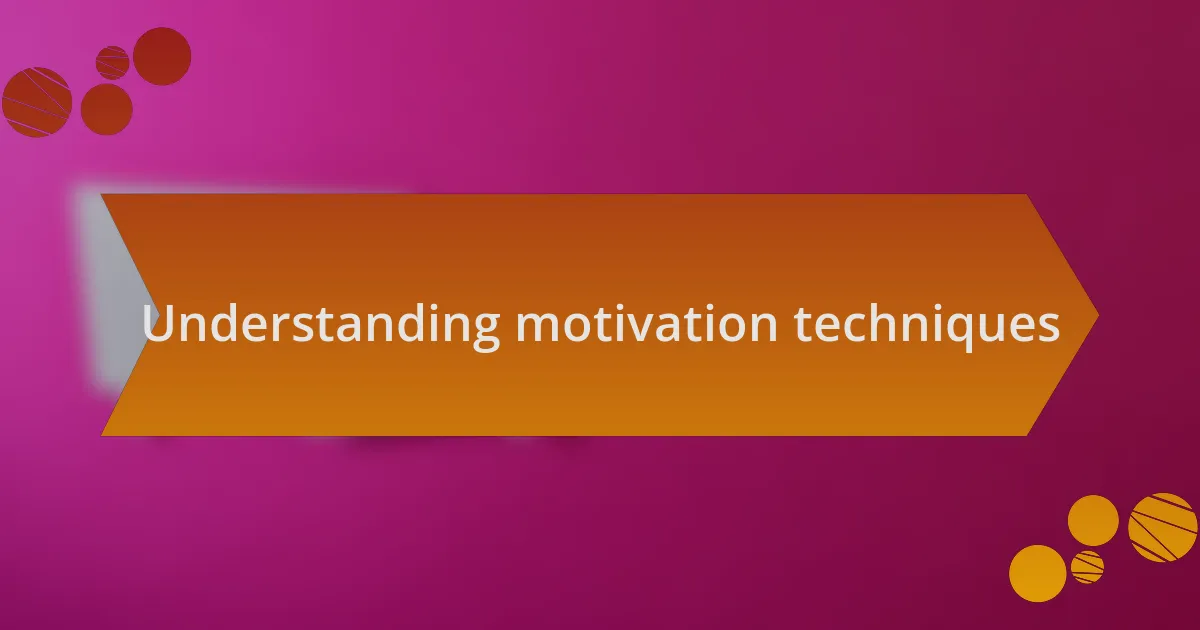
Understanding motivation techniques
When it comes to motivation techniques, I often reflect on my own experiences in art settings. For instance, during a recent workshop, I noticed that participants responded enthusiastically when they could connect their personal stories to the art pieces. Isn’t it fascinating how sharing our feelings can spark a deeper engagement?
One technique I find effective is creating a sense of community among participants. During a group discussion about a specific artwork, I encouraged everyone to share their interpretations. That moment not only fostered connection but also lit a spark of inspiration among attendees. Have you ever felt that rush of enthusiasm when others validate your views?
Another powerful approach is to set clear and attainable goals. I once guided a diverse group through an art project, breaking down the process into manageable steps. By doing this, I saw participants gain confidence as they achieved each milestone. It made me realize how crucial it is to celebrate these small victories together, reinforcing the motivation to keep going.
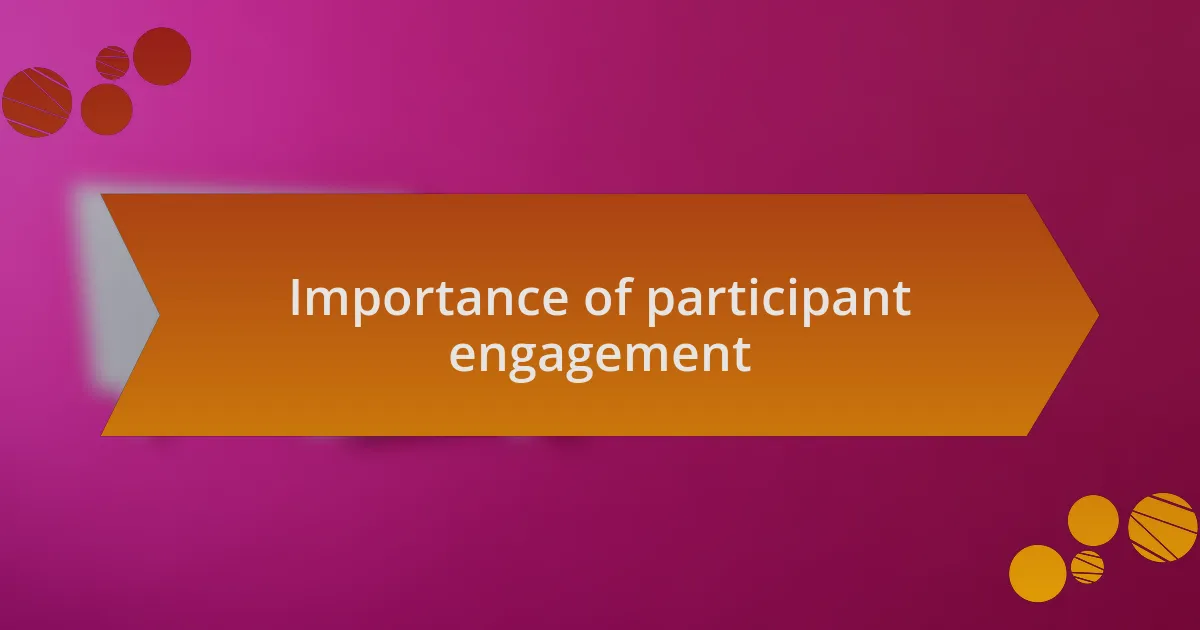
Importance of participant engagement
When participants feel engaged, the artwork resonates more profoundly with them. I remember a time when I organized a community art night. As we explored different styles, the audience’s excitement was palpable; their laughter and shared stories illuminated the space like the art itself. Isn’t it remarkable how energy can transform an event?
Active engagement fosters a sense of belonging, which is vital in any creative environment. I’ve witnessed this firsthand in collaborative art projects, where participants began to build friendships through their shared experiences. This camaraderie not only enriched their understanding of the artwork but also made the entire process feel more rewarding. Don’t you find that those connections can add layers of meaning to what we create together?
Moreover, engaged participants are likely to contribute more creatively. During one exhibition, I encouraged attendees to express their thoughts about the pieces on display. Not surprisingly, many found their voices, offering insights that sparked further discussion. It reminded me how important it is to create spaces where everyone feels their thoughts matter. Wouldn’t you agree that such contributions can elevate the overall experience?
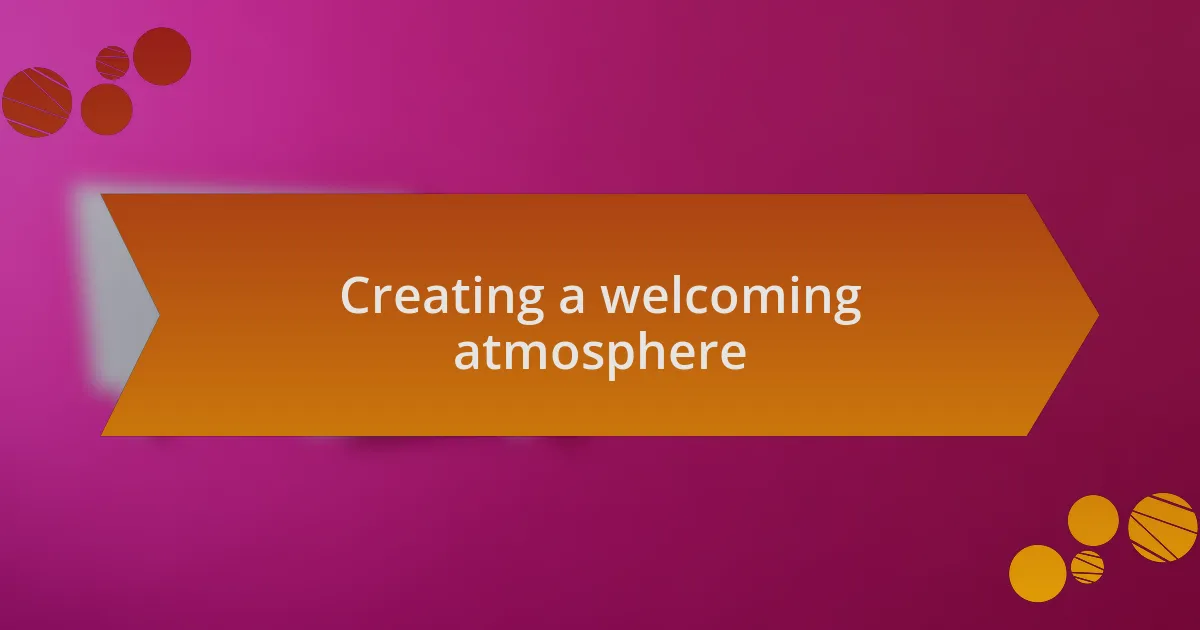
Creating a welcoming atmosphere
Creating a welcoming environment is all about the little details that make participants feel at ease. I remember setting up an art gallery where we carefully arranged cozy seating areas with warm lighting. The moment guests walked in, you could see their shoulders relax and smiles emerge, as if the space itself was inviting them to linger and explore. Don’t you think that such an atmosphere can ignite curiosity?
Moreover, I believe that greeting every participant with genuine warmth sets the tone for their experience. At one opening, I made it a point to learn names and share a few words with newcomers. As their faces lit up with my acknowledgement, it was clear that those simple interactions created a welcoming bubble around them. Isn’t it fascinating how a small gesture can open doors to deeper connections?
Finally, showcasing artwork that reflects diverse perspectives can significantly enhance the feeling of inclusivity. I incorporated pieces from local artists, allowing voices from our community to be seen and heard. The reaction was overwhelmingly positive; people felt proud to be part of something that really represented them. Have you ever noticed how a shared identity can unify a group, transforming a gallery from just a space to a vibrant community hub?
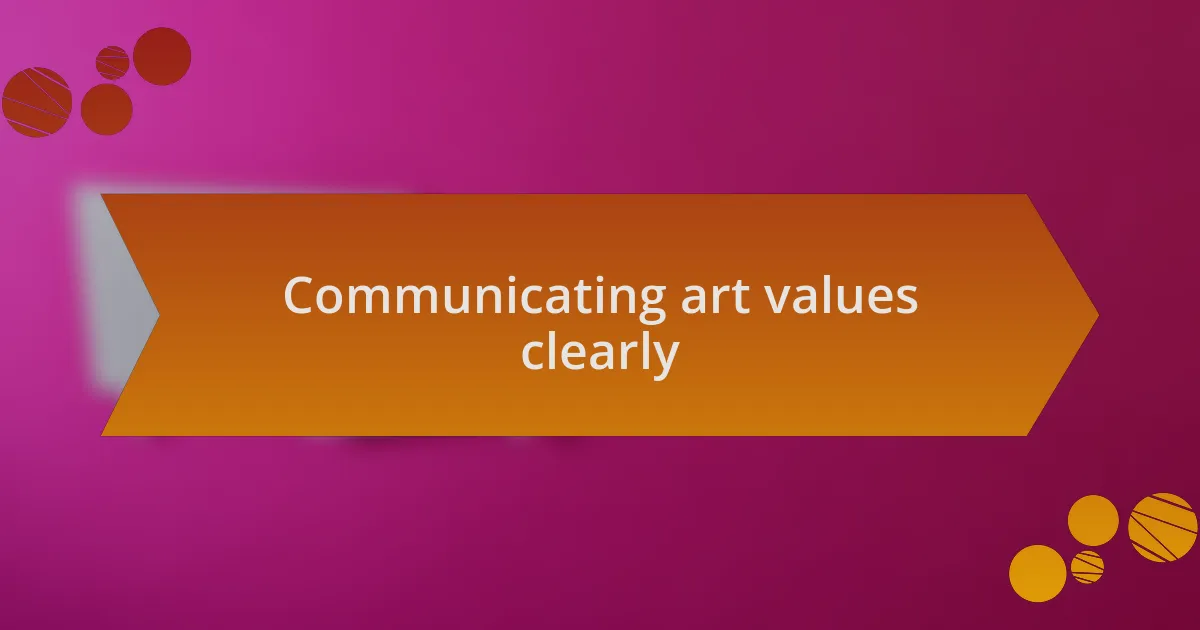
Communicating art values clearly
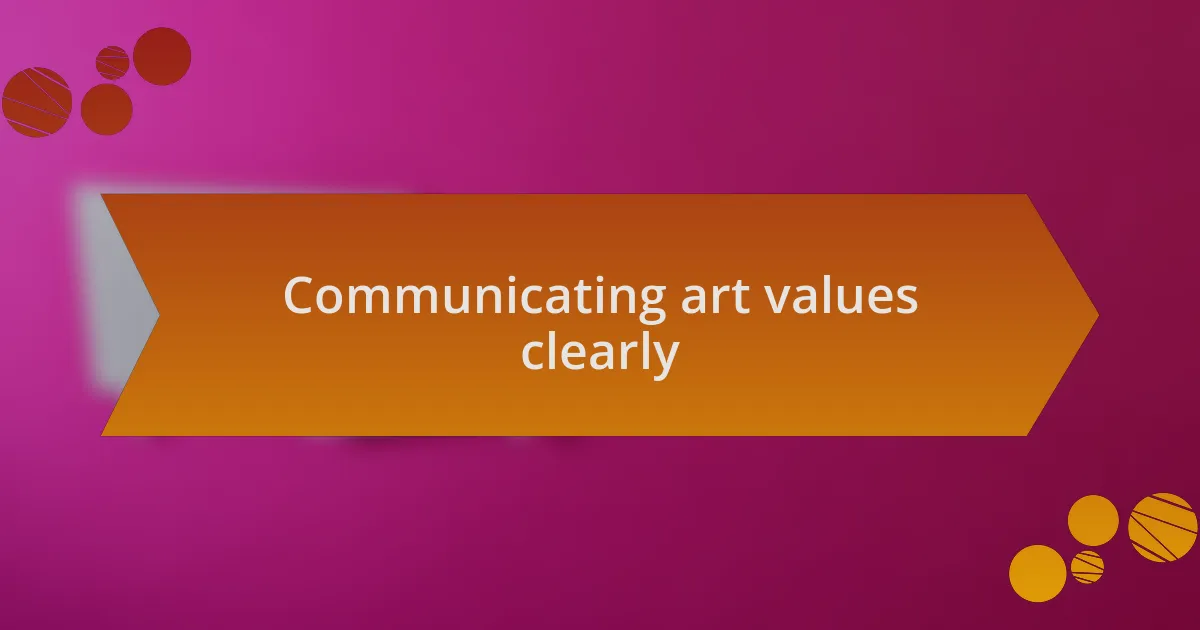
Communicating art values clearly
Effective communication of art values begins with clear messaging that resonates with participants. I once hosted a gallery where I shared the stories behind each piece before the exhibition, which ignited vivid conversations among attendees. Can you imagine how understanding the emotional journey of an artist can transform one’s experience of their work?
Sharing my personal insights encourages participants to engage with the art on a deeper level. During a recent exhibition, I invited guests to express what the pieces meant to them, fostering a dialogue that made each interpretation feel valid and valued. Isn’t it exhilarating how art can elicit such varied responses?
Utilizing a combination of visual cues and verbal narratives is essential in communicating art values. I’ve seen how labels that incorporate not just the artist’s name and medium, but also the story behind the creation can captivate onlookers. It’s amazing what happens when viewers feel connected to the art’s context; they become invested, almost as if the artwork is whispering secrets to them. Have you ever found yourself lost in a piece because of the background it carries?
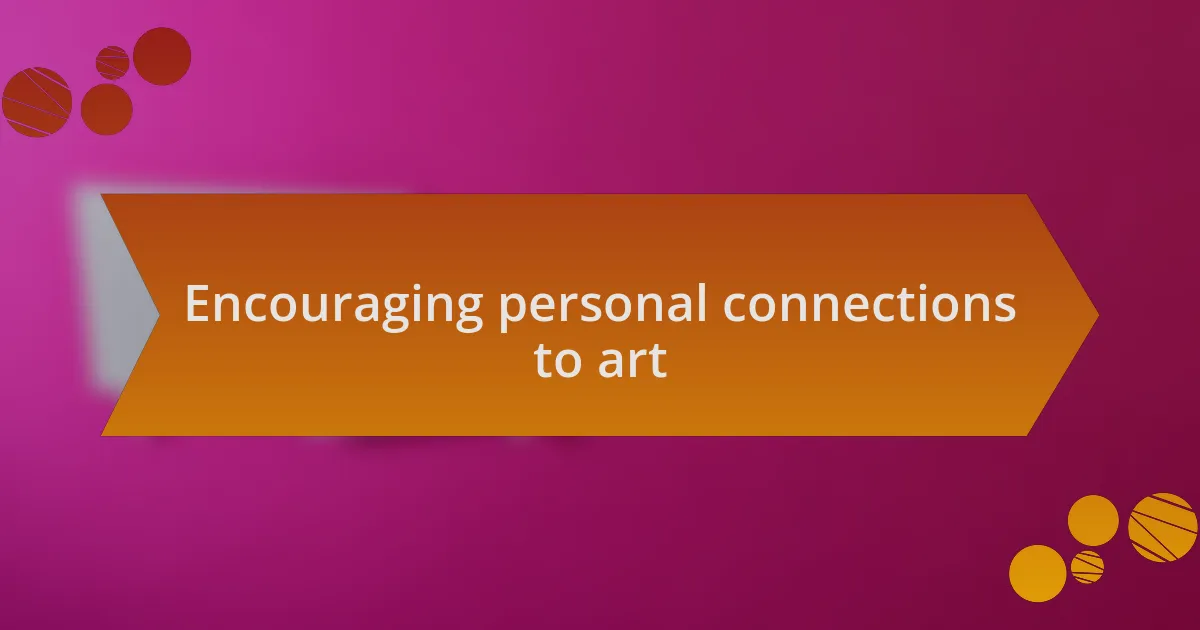
Encouraging personal connections to art
Encouraging personal connections to art can happen when viewers feel their perceptions are welcomed and explored. For instance, during an interactive workshop I ran, I encouraged participants to choose a piece of art that resonated with them personally. It was fascinating to see how their stories influenced the way they interacted with the artwork, transforming a simple viewing into a meaningful experience. Have you ever noticed how a particular piece can remind you of a moment or feeling from your own life?
Art becomes truly powerful when it invites personal reflection. At one gallery event, I shared my own experiences with a painting that touched me deeply, creating a safe space for attendees to share their thoughts. It was touching to witness these bonds forming; people were not just observers, but contributors to a collective understanding of the piece. Isn’t it incredible how personal narratives can add layers to art?
Creating opportunities for dialogue is essential for forging those emotional connections. During my recent exhibit, I implemented small breakout sessions where attendees shared their impressions in small groups. The responses were as diverse as they were heartwarming. It’s in these moments where art transforms from being a solitary experience into a shared journey, leaving everyone inspired. What stories will you bring to your next gallery visit?
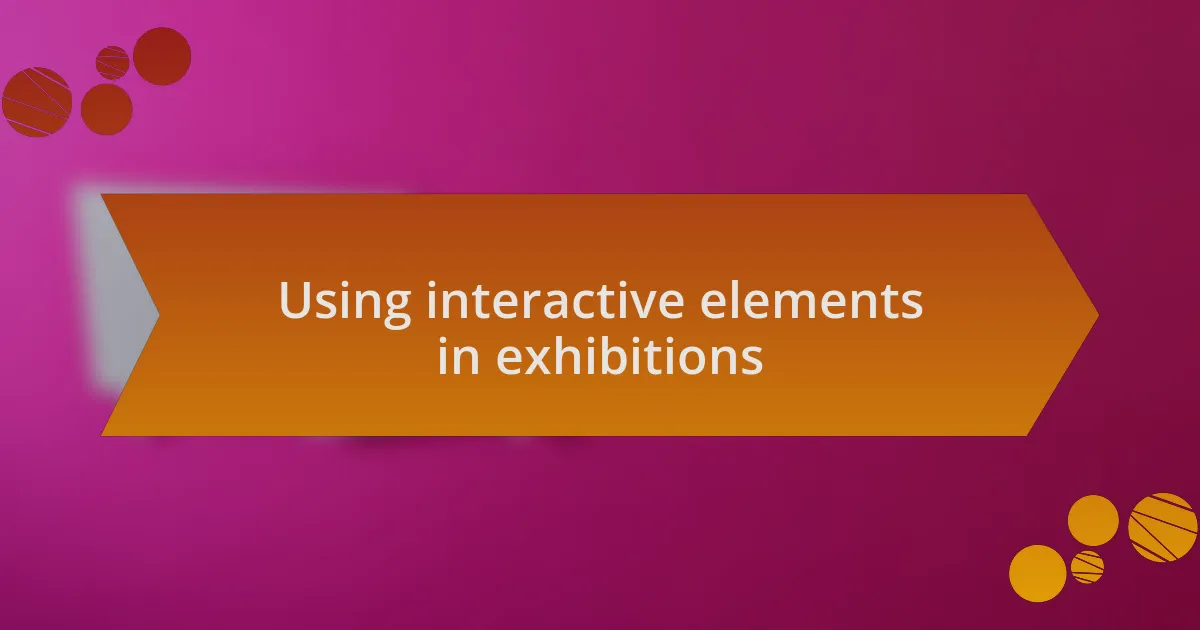
Using interactive elements in exhibitions
Interactive elements can truly elevate an exhibition, as I experienced firsthand during a recent show. I had set up a digital touchscreen where visitors could create their own virtual art pieces, allowing them to express their creativity alongside the exhibited works. Observing the joy and excitement on their faces as they engaged with this technology reminded me of the invigorating spirit of collaboration and community that art can foster.
Incorporating hands-on experiences can also deepen the understanding of artistic techniques. At one exhibition, I introduced a section where participants could experiment with different painting methods, like pouring or splattering paint, just as the featured artists did. I saw attendees who initially felt hesitant transform into confident creators. Have you ever experimented with an artistic technique and discovered a hidden talent in yourself?
Moreover, incorporating social media challenges can create a buzz around the exhibition. I remember hosting a photo contest where visitors snapped creative shots within the gallery and shared them online. The energy was electric as people sought unique perspectives on the art. It not only motivated engagement but also expanded the gallery’s reach, prompting conversations beyond the physical space. How might you use social media to connect people to art in new and exciting ways?